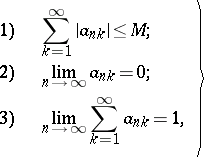Regularity criteria
for summation methods
Conditions for the regularity of summation methods.
For a matrix summation method defined by a transformation of a sequence into a sequence by means of a matrix  ,
,  the conditions
the conditions
 | (1) |
are necessary and sufficient for regularity. For the matrix summation method defined by a transformation of a series into a sequence by means of a matrix  ,
,  necessary and sufficient conditions for regularity are as follows:
necessary and sufficient conditions for regularity are as follows:
 | (2) |
The conditions (1) were originally established by O. Toeplitz [1] for triangular summation methods, and were then extended by H. Steinhaus [2] to arbitrary matrix summation methods. In connection with this, a matrix satisfying conditions (1) is sometimes called a Toeplitz matrix or a  -matrix.
-matrix.
For a semi-continuous summation method, defined by a transformation of a sequence into a function by means of a semi-continuous matrix  or a transformation of a series into a function by means of a semi-continuous matrix
or a transformation of a series into a function by means of a semi-continuous matrix  , there are regularity criteria analogous to conditions (1) and (2), respectively.
, there are regularity criteria analogous to conditions (1) and (2), respectively.
A regular matrix summation method is completely regular if all entries of the transformation matrix are non-negative. This condition is in general not necessary for complete regularity.
References
| [1] | O. Toeplitz, Prace Mat. Fiz. , 22 (1911) pp. 113–119 |
| [2] | H. Steinhaus, "Some remarks on the generalization of the concept of limit" , Selected Math. Papers , Polish Acad. Sci. (1985) pp. 88–100 |
| [3] | G.H. Hardy, "Divergent series" , Clarendon Press (1949) |
| [4] | R.G. Cooke, "Infinite matrices and sequence spaces" , Macmillan (1950) |
Comments
Cf. also Regular summation methods.
Usually, the phrase Toeplitz matrix refers to a matrix  with
with  for all
for all  with
with  .
.
Regularity criteria. Encyclopedia of Mathematics. URL: http://encyclopediaofmath.org/index.php?title=Regularity_criteria&oldid=49557